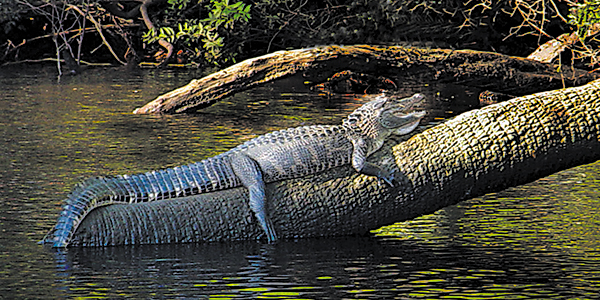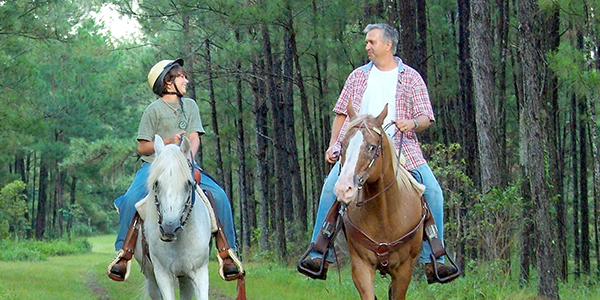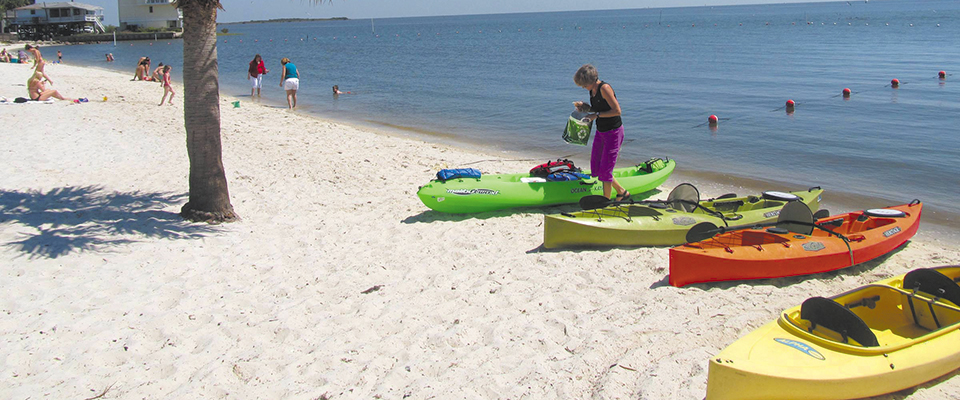Spotlight: Levy County/Cedar Key
Go wild in this untamed slice of the Sunshine State
Locals of Levy (Lee-vee) County call this slice of north Florida the Nature Coast. Fully one-fifth of the county is set aside for state and national wildlife areas, and when you poke around the back roads and through the dense hardwood forests, marshes and sandhills, you will find more than two-dozen nature-based recreational sites.
The biggest outdoor playground is the Goethe State Forest, with 53,000 accessible acres across southeastern Levy County. This is horse country (1975 Kentucky Derby winner Foolish Pleasure was a Levy native) and trail riders flock to the Black Prong Equestrian Center. This is the gateway to over 150 miles of hoof-friendly passages through scrubby flatwoods and cypress swamps.
Not all recreational opportunities in Levy County lie above ground. About half of Florida’s 400 freshwater springs percolate within the Suwannee River Basin (the river Stephen Foster wrote a song about but never saw). Sometimes the surface sinks right into the aquifer like at Devil’s Den Spring, where scuba divers descend 30 feet underground to open dive. Less experienced underwater explorers can snorkel in the springs. Nearby, Blue Grotto is a dive park built into a spacious natural limestone cavern. Snorkeling is also on the menu at Manatee Springs State Park and Fanning Springs State Park—spring water in Levy County is 72 degrees year round.

Levy County Florida
The best way to explore the nooks and crannies of Florida’s Nature Coast is by boat, canoe or kayak. That is the only way to access the Waccasassa Bay Preserve State Park, which preserves 32,000 acres of coastal wilderness on the Gulf of Mexico. The Wekiva River has managed to survive as one of the few pristine riverine systems in Florida, and Henry Beck Park can be used for a launch site onto the Wekiva to paddle down a mapped State Canoe Trail.
Levy Locals
Although Great Blue Herons, manatees and wild hogs outnumber humans in the area, Levy County homo sapiens have nonetheless made their mark in charming towns that evoke the term “Old Florida.” Renowned for its production of peanuts, Williston sits on the eastern edge of the county. The goober—a roasted, boiled, fired and baked peanut—is celebrated the first Saturday of October at the Central Florida Peanut Festival. At the Cedar Lakes Woods and Gardens, more than 50 botanical showcases have been planted amidst the waterfalls of an abandoned 100-year-old lime rock quarry.
Feeling adventurous? Check out the 13 islands that make up the Cedar Keys National Wildlife Refuge. Here, you’ll find the fishing village of Cedar Key, which traces its origins back to a United States Army fort in 1839. In 1854, a 28-foot-tall lighthouse was constructed on a 47-foot-high sandhill on Seahorse Key. The sandhill is the highest natural elevation on the Florida Gulf Coast, and the lighthouse still stands. Cedar Key, which takes its name from the abundant red cedar that once grew on the shore, was a bit of a boomtown in those days. The Florida Railroad was the first to connect the Atlantic and Gulf Coasts, and its western terminus was Cedar Key.
For generations, the residents of Cedar Key made a living hauling sea trout, redfish and tarpon from the flats around the island. But in 1994, the State of Florida enacted a ban on net fishing that abruptly brought an end to “Old Florida” life. The state did, however, provide resources for Cedar Key watermen to begin aquaculture. Today, the village is the leading clam farming community in the United States. Those clams are put to good use in the traditional seafood restaurants that line the waterfront streets in Cedar Key. The clam chowder at Tony’s Seafood Restaurant on 2nd Street has three times scored top honors at the International Clam Chowder competition. If you want to catch your own seafood dinner, drop a line in at the Cedar Key Fishing Pier on Dock Street; many of the town restaurants will be happy to cook up your bounty from the sea.

Levy County Florida
Deep History
The Cedar Key Historical Society Museum captures the evolution of the Gulf Cost Island community from one of Florida’s early important towns to a quaint fishing village and artists’ retreat. Over at the Cedar Key State Museum, the collection of shells and Indian artifacts assembled by resident Saint Clair Whitman have been preserved in his 1880s frame house. Human habitation from 1,800 years ago on Cedar Key is interpreted at the Shell Mound Unit of Lower Suwannee National Wildlife Refuge. The mound was created by Eastern Woodland Indians who’d lived here for at least 1,000 years.
For More Information
Florida Department of Tourism
888-735-2872
www.visitflorida.com






